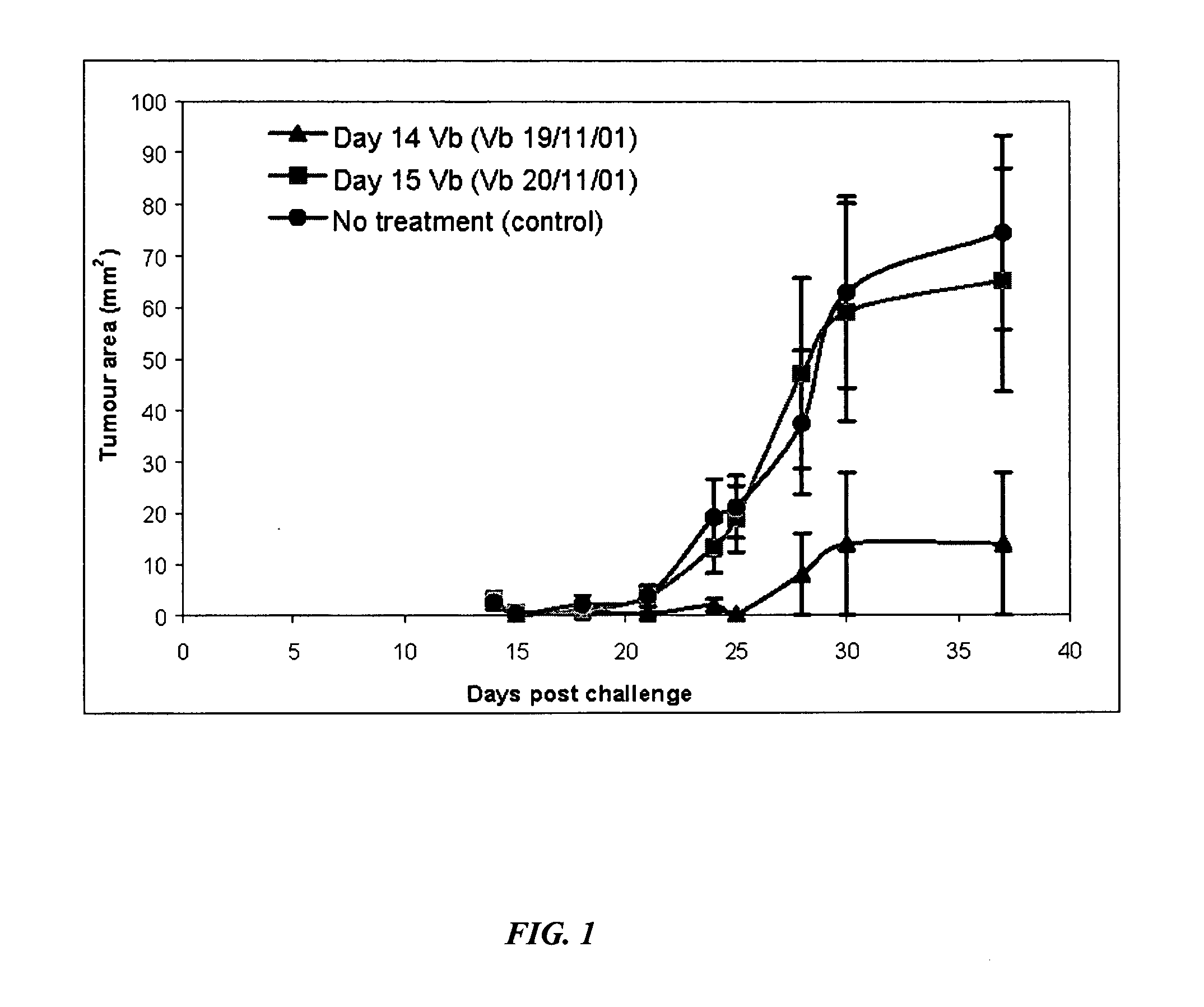Cancer therapy
a cancer and tumor technology, applied in the field of cancer therapy, can solve the problems affecting the survival rate of patients, so as to achieve the effect of limiting the mammal's ability to effectively control or eradicate the tumor
- Summary
- Abstract
- Description
- Claims
- Application Information
AI Technical Summary
Benefits of technology
Problems solved by technology
Method used
Image
Examples
example 1
[0093] Malignant mesothelioma in humans is an asbestos induced, incurable tumor that has a particularly poor prognosis. Average time from diagnosis to death being only eight months (Musk and Woodward, 1982). A murine model was developed by researchers in the Department of Medicine at the University of Western Australia to further the development of suitable interventions (Davies et al., 1992). The murine tumors exhibit morphological features, distributions, and mode of spread in body cavities consistent with the human clinical situation.
[0094] Day 0 was defined as the day of tumor cell inoculation with 1×106 AE 17 cells subcutaneously. The AE 17 tumor cell line was derived from C57 / B16 mice and inoculated back into the same strain. This point will be referred to as a tumor challenge henceforth. Three groups of 5 mice were all challenged in this way. Subsequently the first of the groups was given a single ip dose of vinblastine (Vb) at 6 mg / kg body weight exactly 14 days post tumor ...
example 2
[0097] A prostate cancer patient with elevated levels of PSA associated with the cancer is subjected to a standard chemotherapy regime involving cyclophosphamide (for example, as described by Casciato and Lowitz, 1995). Upon completion of the chemotherapy the patient is monitored for the PSA marker. Such monitoring should preferably occur at least every 24 hours after the completion of chemotherapy and continue for at least one month.
[0098] If PSA marker levels begin to elevate it will be clear that the chemotherapy is not completely successful. PSA levels are continued to be monitored until levels of PSA are decreasing. This indicates that the effector cells are beginning to control the new cancerous cells. At approximately this point vinblastine is administered to the patient at a standard dose such as 3-4 mg / m2 intravenously (Casciato and Lowitz, 1995). Vinblastine will target dividing cells, such as the regulator cells, which begin to clonally expand to control effector cell le...
example 3
[0100] A breast cancer patient with elevated levels of CA 15-3 (epitope of Polymorphic Epithelial Mucin) associated with the cancer is subjected to surgery in an attempt to remove the tumor. Upon completion of the chemotherapy the patient is monitored for the CA 15-3 marker. Such monitoring should preferably occur at least every 24 hours after surgery and continue for at least one month.
[0101] If CA 15-3 marker levels begin to elevate it is clear that all of the tumor cells are not removed by the surgery. CA 15-3 levels are continued to be monitored until levels of CA 15-3 are decreasing. This indicates that the effector cells are beginning to control the new cancerous cells. The patient is then subjected to radiation therapy to target dividing cells, for example provided as megavoltage gamma irradiation to the entire breast (about 4500-5000 cGy) (Casciato and Lowitz, 1995).
[0102] The patient is further monitored for CA 15-3 levels to ensure that the cancer is controlled. Treatmen...
PUM
| Property | Measurement | Unit |
|---|---|---|
| Time | aaaaa | aaaaa |
| Time | aaaaa | aaaaa |
| Level | aaaaa | aaaaa |
Abstract
Description
Claims
Application Information
 Login to View More
Login to View More - R&D
- Intellectual Property
- Life Sciences
- Materials
- Tech Scout
- Unparalleled Data Quality
- Higher Quality Content
- 60% Fewer Hallucinations
Browse by: Latest US Patents, China's latest patents, Technical Efficacy Thesaurus, Application Domain, Technology Topic, Popular Technical Reports.
© 2025 PatSnap. All rights reserved.Legal|Privacy policy|Modern Slavery Act Transparency Statement|Sitemap|About US| Contact US: help@patsnap.com

